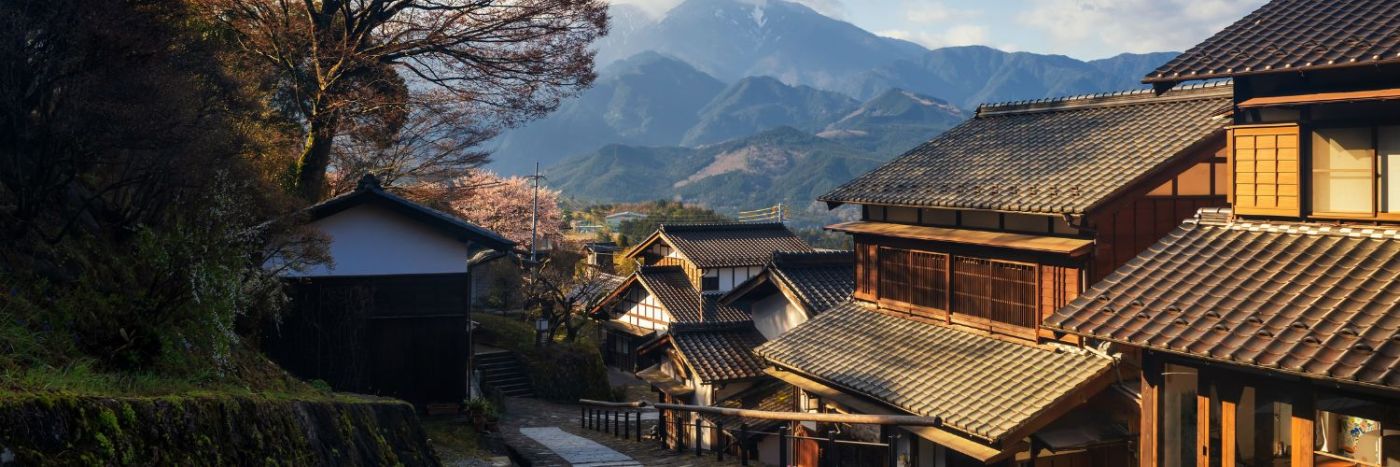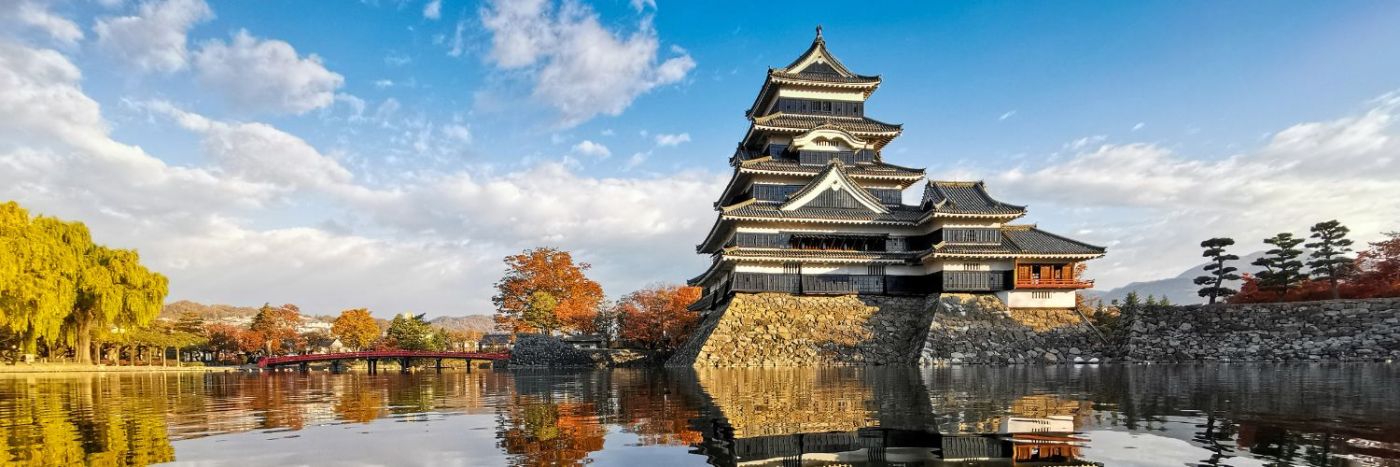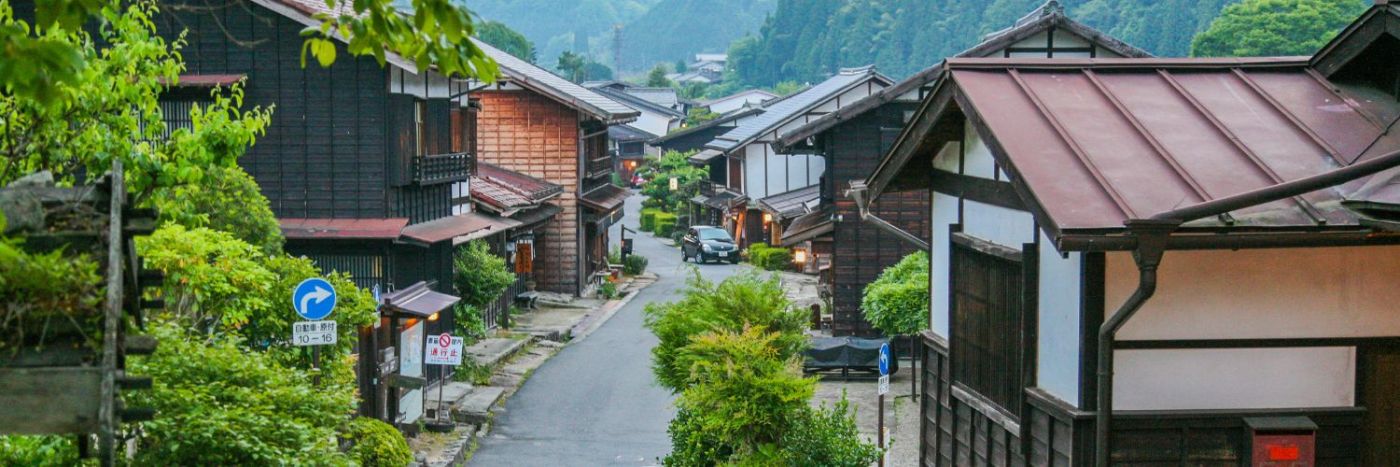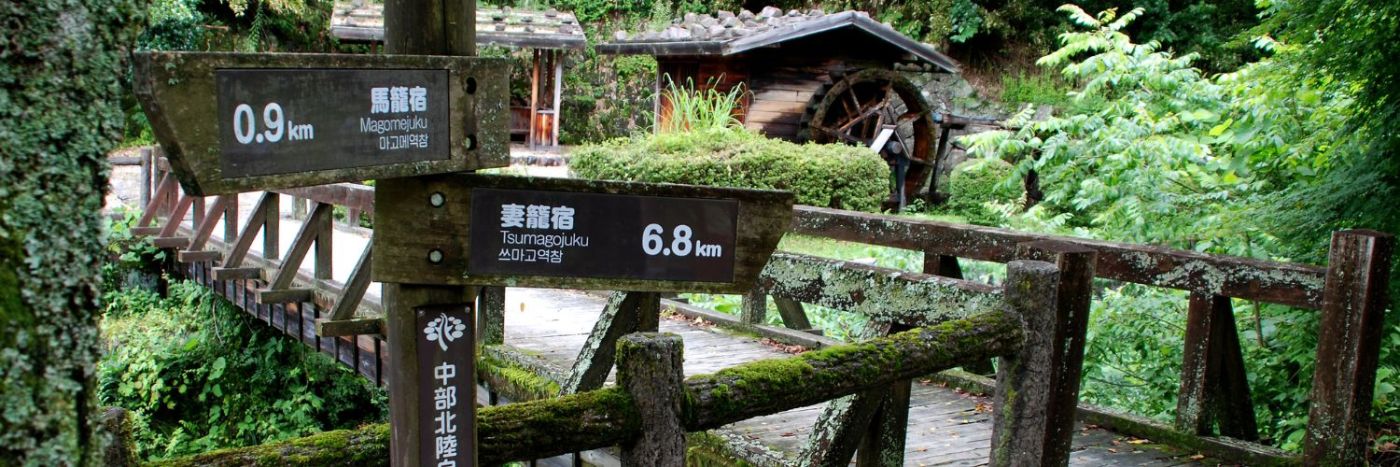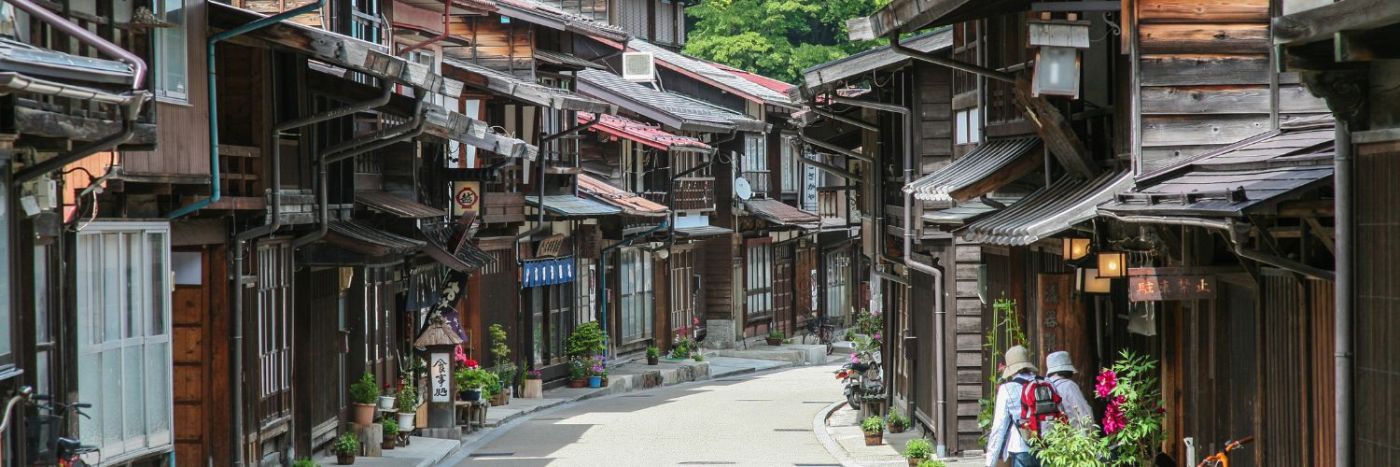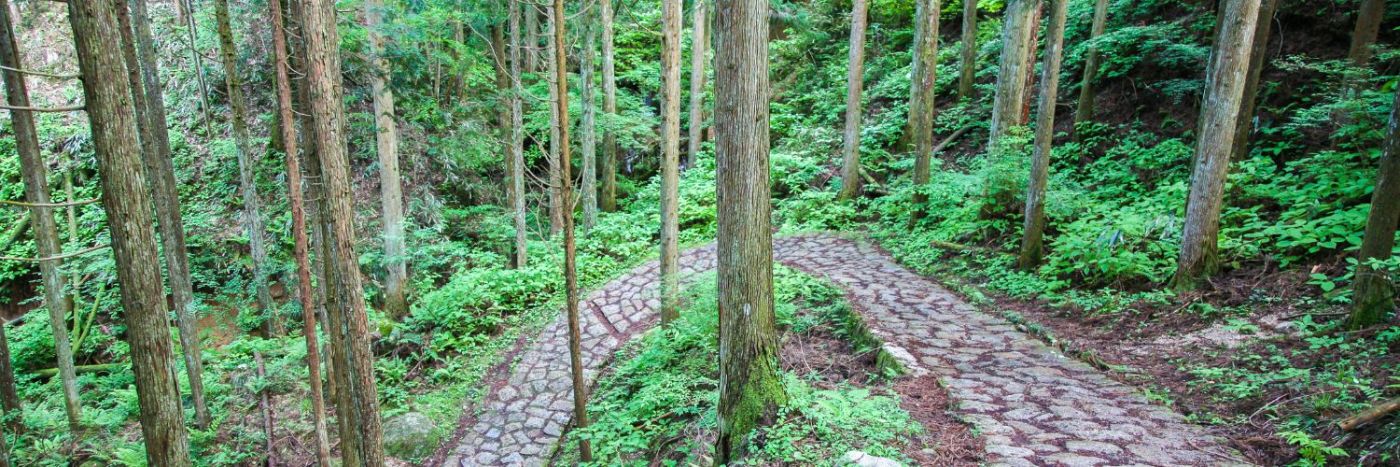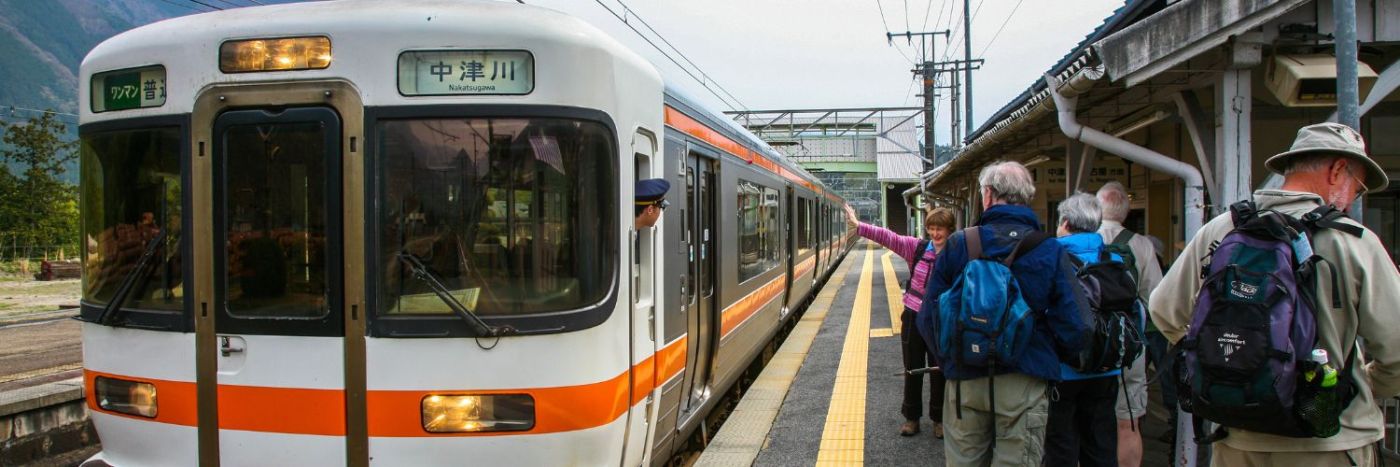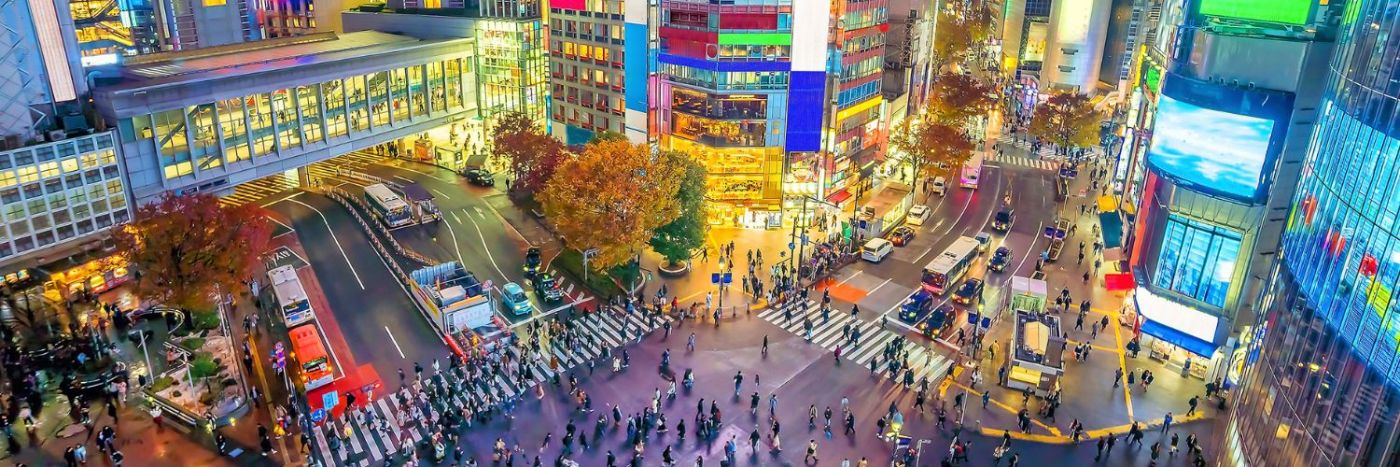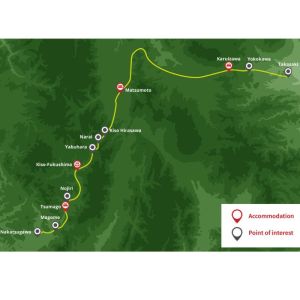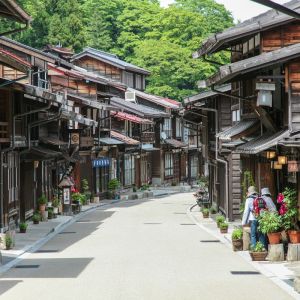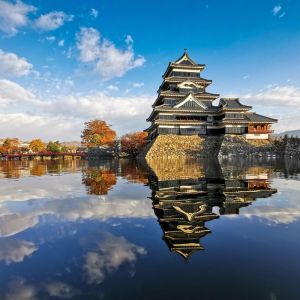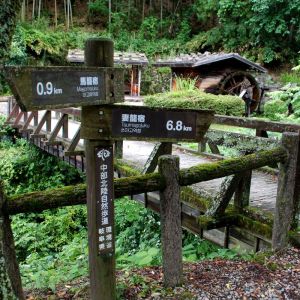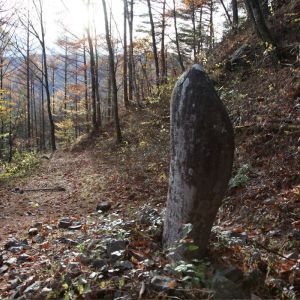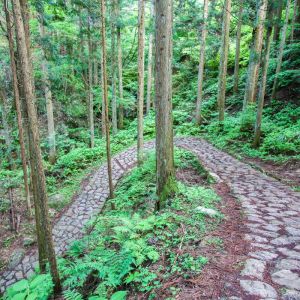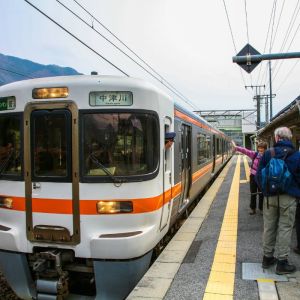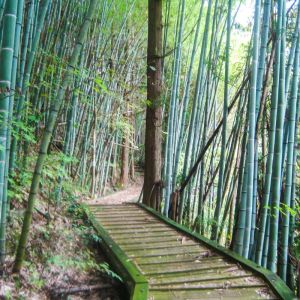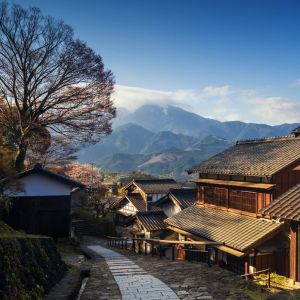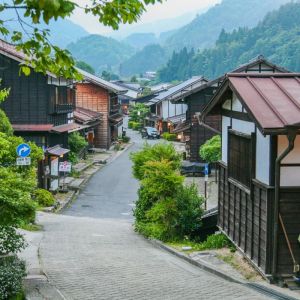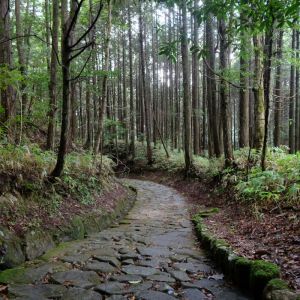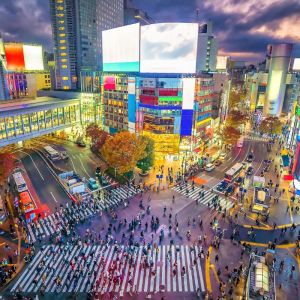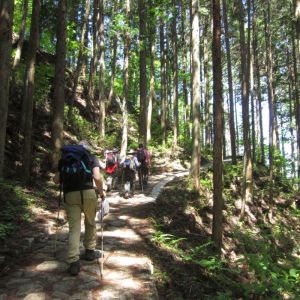- Overview
- Map & Itinerary
- Essential Info
- Pics & Vids
- Dates & Prices
Highlights
- Walk village to village along the most charming sections of the ancient Nakasendō Trail
- Follow in the footsteps of Samurai warriors on the Nakasendō Trail
- Soak in the thermal waters at a traditional hot spring ryokan
- Stand in awe of Matsumoto Castle, a ‘National Treasure’ and the oldest five-tiered, six-story castle tower remaining in Japan
- Explore the beautifully preserved villages of Magome, Tsumago, and Narai
- Travel by the world-famous bullet train from Tokyo to Nagoya.
Overview
The Nakasendō Trail Self-Guided Trek invites you to step into the heart of Japan, a land where ancient traditions weave through the fabric of modern life with a seamless grace. This trek isn’t just a walk; it’s a passage through time on one of Japan’s most historic pathways, the Nakasendō Trail. Once the northern mountain route between Tokyo and Kyoto, it was lined with 69 post towns serving as overnight stopping points where travellers could find food, lodging, and entertainment. This route has been meticulously restored to reflect its historical significance during the Edo period (1603-1867), offering you an immersive peek into Japan’s pre-modern era.
Your adventure begins in the vibrant city of Tokyo, where you’ll take the iconic bullet train to Nagoya, bridging the gap between the bustling capital and the serene landscapes of central Japan. A local bus ride to Magome ushers you into a different era, setting the stage for what will be a profound connection to the storied paths once traveled by samurai, merchants, and nobles. Weaving through the mountains of central Japan, the historic Nakasendo Trail connected Kyoto and Edo-period Tokyo. This trail stretches 534km and the villages along the way, known as juku, provided accommodation for weary travellers walking along this route dating back to the seventh century.
Following ancient paved village paths and mountain trails, you walk between perfectly preserved Nakasendo post towns such as Tsumago, Nojiri, Yabuhara and Hirasawa. Each night you will stay in small local minshuku or ryokan where you will be welcomed as one of the family and enjoy the warm hospitality. In Magome, Tsumago, and Narai, every stone path, every wooden building, breathes stories of yesteryears – thanks to the passionate conservation efforts of the locals. Walking this trail, you are walking the same paths where history was made, experiencing a sense of connection to those who walked before you.
The Nakasendō Trail Self Guided Trek is more than a spiritual route through the mountains; it is a deep engagement with culture, history, and the enduring spirit of Japan. It’s an invitation to slow down and reflect, to absorb the beauty of nature and the legacy of human endeavor. This trek is your gateway to not just see Japan, but to feel it, in the respectful silence of the ancient roads and the preserved beauty of the juku towns that have withstood the relentless test of time.
If you wish to extend your self-guided trip, you can combine this trek with the pilgrimage journey along The Kumano Kodō Trail.
Arrive in Tokyo Japan
Your adventure begins in Tokyo, a lively city which dazzles with it’s mixture of the ultramodern and the traditional, from neon-lit skyscrapers to historic temples. As the world’s most populous metropolis, there’s plenty to see and experience.
We recommend arriving at Haneda Airport (HND), as it is very close to Tokyo city and serviced by multiple trains, taxi’s and monorail. Dependent on your flight time, you may have the chance to explore some of the wealth of history, culture, cuisine, commerce and street life of this vibrant capital city. From the contrasting architecture to a dynamic arts scene to incredible dining throughout.
If you would prefer to have a guide to help you get to grips with the unique Japanese culture and history it is possible to add a private guide to your day.
Included
Accommodation: One night’s stay. Our hotels are 3*- 4* and either local or Japanese western style hotels. We don’t work with large multinational chains.
Meals: Not included
Hike from Magome to Tsumago
You’ll receive train tickets for your journey starting from Tokyo to Nakatsugawa. This includes a journey on the world-famous bullet train to Nagoya. At Nakatsugawa, you’ll board a local bus for the short journey to Magome impressively positioned at 800m above the Kiso Valley. This beautifully preserved former post town with it’s cobled road, working waterwheels and seasonal flowers, offers expansive views over the rice fields and surrounding countryside. It stands as one of Japan’s most serene destinations.
Your trekking journey begins as you walk over Magome Pass to Tsumago, one of the best-preserved and most evocative of the Nakasendo post towns.
Spend the night at a family-run minshuku in Tsumago or the nearby hamlet of O-Tsumago. Enjoy a delicious home-cooked Japanese dinner.
Trekking details
Walking distance: 8.3 km / 5.2 miles
Elevation gain: 326 m / 1,069 ft of ascent and 430 m / 1,410 ft of descent
Time required: Approx. 3 hours
Included
Train: Train tickets from Kyōto or Tōkyō to the trail and from the trail to Tōkyō
Accommodation: Minshuku (family-run guesthouse)
Meals: Dinner
Trek from Tsumago to Nojiri. Train to Kiso-Fukushima
The longest day on the trail is a beautiful and varied hike from Tsumago to Nojiri. The trail travels through small valleys and past forests of bamboo and Japanese cedar, through some of the most unspoilt scenery on the trail. Continue by train to Kiso-Fukushima, a historic post town that once flourished as a political and economic centre in the Kiso Valley. Tonight, enjoy kaiseki-style cuisine and hot spring baths.
Trekking details
Walking distance: 18.4 km / 11.5 miles
Elevation gain: 723 m / 2,275 ft of ascent and 644 m / 2,112 ft of descent
Time required: Approx. 6 hours
Included
Train: Train ticket for intermediate journeys on the Nakasendo Trail which can be pre-booked in advance
Accommodation: Onsen ryokan (hot spring inn) or onsen hotel (hot spring hotel)
Meals: Breakfast & dinner
Trek from Yabuhara to Narai and on to Kiso-Hirasawa
Your journey continues first by train from Kiso Fukushima to Yabuhara, the starting point for the hike over the Torii-tōge Pass to Narai.Explore this atmospheric village before you continue on today’s journey.
From Yabuhara the trail climbs the Torii-toge Pass, one of the hardest parts of the Nakasendo, to the village of Narai. This historic town was one of the most prosperous of the 69 towns on the Nakasendo Trail. The residents here impose strict rules on ownership of the homes ensuring it remains traditional and locally retained.
Your walk continues a little further along the trail to Kiso Hirasawa, which is famous for its lacquerware. There are many small shops selling beautifully crafted tableware and furniture.
From Kiso-Hirasawa you transfer by train (approx. 2hrs) to the castle town of Matsumoto. Your hosts will serve a welcomed home-cooked Japanese dinner and breakfast.
Trekking details
Walking distance: 8.7 km / 5.5 miles
Elevation gain: 344 m / 1,128 ft of ascent and 270 m / 885 ft of descent
Time required: Approx. 4 hours
Included
Train: Train ticket for intermediate journeys on the Nakasendo Trail which can be pre-booked in advance
Accommodation: Minshuku (family-run guesthouse) or ryokan (traditional Japanese inn)
Meals: Breakfast & dinner
Exploring Matsumoto and transfer to Karuizawa
After breakfast, you will have time dedicated to exploring the vibrant city of Matsumoto which sits in a fertile valley, with the magnificent northern Japan Alps, in all their splendour, to the west. Formerly known as Fukashi, Nagano Prefecture’s second-largest city has been here since the 8th century.
Highly recommended is a visit to Matsumoto Castle, one of only 12 castles in Japan that has retained its original interior and exterior structures. Once you’ve finished exploring Matsumoto, you’ll travel by train to your final stop for your onward journey (approx. 2hrs) to Karuizawa. This town has a real sense of history and fine Japanese baths. Arrive at your accommodation in time for a wonderful dinner featuring local produce.
Included
Train: Train ticket for intermediate journeys on the Nakasendo Trail which can be pre-booked in advance
Accommodation: Ryokan (traditional Japanese inn)
Meals: Breakfast & dinner
Trek from Karuizawa to Yokokawa. Train to Tokyo
Following breakfast, embark on your final trek along the Nakasendo Trail, journeying from Karuizawa to Yokokawa. Departing Karuizawa, the path leads over the Usui-tōge Pass and descends gently through one of the trail’s most picturesque stretches. Upon reaching Yokokawa, take a local train to Takasaki, where you’ll transfer to the bullet train bound for Tokyo. The train journey is approximately 2 hours, bringing you to Tokyo in the late afternoon or early evening.
Please note, the walk can be shortened by 5.9 km / 3.7 miles by a taxi ride at the start of the day if needed.
Trekking details
Walking distance: 16.7 km / 10 miles
Elevation gain: 372 m / 1,220 ft of ascent and 862 m / 2,828 ft of descent
Time required: Approx. 5 – 6 hours
Included
Accommodation: City-centre hotel
Meals: Breakfast only
Discover Tokyo prior to your onward travel
Depending on your travel plans, spend some time exploring the old and new sections of the vibrant city of Tokyo. You have the option to either organise your return flight home, extend your stay in Tokyo or add on the Kumano Kodo Self Guided Trek.
Highlights of Tokyo include Ueno Park and the Tokyo National Museum, the grand Meiji Shrine, the trendy Harajuku district, and the famous Tsukiji Fish Market.
Included
Meals: Breakfast only
At Adventurous Ewe we consider sustainability aspects in destinations in the selection of new destinations and we’re delighted to report that nature is deeply present in Japanese people’s life and thus ecotourism is a wonderful way of discovering both Japanese culture and landscape. Japan has now its own Sustainable Tourism Standards for Destinations accredited by the GSTC proving the country’s engagement to guide destinations through implementing sustainable tourism. For these reasons, we have compiled some new adventures to this forward thinking country.
In developing our new self-guided treks, we have consciously avoided directing more tourists to areas already impacted by overtourism. For instance, our routes do not include Fujikawaguchiko, a location grappling with the effects of overcrowding and disruptive tourist behavior at a renowned photography spot overlooking Mount Fuji. In response to these challenges, local authorities plan to erect a large black barrier to obscure the view of the iconic mountain, aiming to mitigate the adverse effects of excessive tourist visits.
We develop and host sustainable adventures to help support local communities and give you the chance to have a more meaningful travel experience. This trek to rural areas of Japan has been created in line with our Travelife Partner award in sustainable tourism.
Discover the country at your own pace with our detailed maps and walking instructions. Everything else – from rail tickets to accommodations – are all organised by us, so you can focus on relaxing and enjoying excellent local home-cooked meals and world class hospitality. The route is waymarked (in English and Japanese) and we provide detailed route notes and topographic maps so you should have no problem following the trail.
FLEXIBILITY
You get to choose the day of the week to start your adventure, within our specified periods of when best to travel, allowing you to take advantage of low-cost flights or make the most of your precious leave by arranging travel around a Bank Holiday or weekend. You can start on any day of the week, subject to availability, between April and October.
YOU CHOOSE THE PACE
Travelling independently gives you the freedom to go at your own pace. If you fancy a lie-in, have one! It’s your holiday. With no group times to stick to you can take the day as you like, whether that’s indulging in a leisurely breakfast or speeding ahead to settle in your accommodation and explore each destination to the full.
PICK YOUR TRAVEL COMPANIONS
With self-guided you choose who you travel with, whether that’s your partner, your family or a group of friends. You let us know who would like to go with, and we’ll arrange the rest.
IMMERSE YOURSELF IN YOUR CHOSEN DESTINATION
The best thing about a self-guided trip is that you get to see places you might otherwise miss. Stop at a temple you might have passed by, linger in a courtyard and savour your drink, peruse local markets or chat with the locals.
SAMPLE THE LOCAL FOOD
Exploring independently allows you the opportunity to indulge in all the local delicacies the area has to offer, allowing you to find the best sushi and sashimi, find some freshly cultivated sansai (mountain vegetables) or sample some micro-brewed sake.
BOOK WITH CONFIDENCE
Relax in the knowledge that we have made all your arrangements for you. From your starting point to your departure we have it covered. We handpick your accommodation, transport your bags each day and provide you with all the route details and information you need to have a fantastic trekking journey. And don’t forget, a self-guided adventure doesn’t mean you’re all on your own. The local team is only a phone call away to offer a helping hand, should you need it.
On booking your Nakasendō Trail Japan Self-Guided Trek, you’ll receive all the exciting trip info via our free mobile travel app.
You’ll have access to your itinerary, trip countdown, live updates, contact info, weather forecasts, know before you go trip info, kit lists and much more at the touch of a button 24 hours a day via your mobile phone. No more unnecessary use of reams of paper to benefit the environment and the need of carrying around documents with you. A’ppy days.
With being a small family business we pride ourselves with providing personal, professional and friendly service. We appreciate that everyone has different levels of experience and reasons for wishing to embark on the Nakasendō Trail Japan Self-Guided Trek and therefore require varying levels of support and guidance.
We’re here to help you every step of the way from the moment you join the flock all the way through to completing the challenge and beyond. Jim and Sue’s knowledge and expertise stems from dozens of years of travelling and exploring the destinations that we visit in order to fully support you in the lead up to your adventure. We’re here to help you with any questions, no matter how big or small, and it’s not often that you’re able to speak directly with the owners of the business who have so much passion for travelling in Japan.
We recommend you book your flights to arrive and depart from Haneda Airport which is very close to Tokyo city and serviced by multiple trains, taxi’s and monorail Airport. You’re welcome to book your flights directly with the airline or you can use our Flight Agent who is ATOL & ABTA and pay their direct cost (there is no mark up on these flights from Adventurous Ewe).
Flights are not included in your package to give you the flexibility to travel from your nearest airport, use your frequent flyer points or extend your stay in Japan if you wish.
Please make sure you have confirmed, round-trip air tickets to Japan. Most airlines will require you to have either a return ticket, or a ticket to an onward destination following your stay in Japan. They may deny you boarding if you only have a one-way ticket.
Please DO NOT book your flights before you have received your booking confirmation and your deposit has been taken.
All nationalities require a full passport that must be valid for the length of your stay in Japan.
British citizens: for the most up to date info, please visit the Foreign & Commonwealth Office website.
Australian citizens: for the most up to date info, please visit Smart Traveller Japan.
Please note, you must carry your passport (or Japanese residency card) with you at all times whilst in Japan.
British citizens, you can travel to Japan for tourism or business for up to 90 days. You will get a visa in your passport on arrival, and you do not need to apply before you travel. The Japanese immigration authorities may extend your visa by another 90 days at their discretion. You will need to apply for an extension.
Australians are eligible for Japan’s visa exemption scheme for short-stay tourism and business travel. You don’t need a visa to travel to Japan for up to 90 days. Entry and exit conditions can change at short notice. It is your responsibility to verify visa requirements from the nearest embassy or consulate of Japan.
We recommend that you check with the nearest embassy or consulate of your chosen destination(s), including any countries you may be transiting or transferring through.
Some local governments provide guidance on what visas their citizens need. To help, we’ve gathered a selection of useful links below.
- Australia: www.smartraveller.gov.au/destinations/asia/japan
- Canada: www.travel.gc.ca/destinations/japan
- United Kingdom: www.gov.uk/foreign-travel-advice/japan/entry-requirements
- USA: www.travel.state.gov/content/travel/en/international-travel/International-Travel-Country-Information-Pages/Japan.html
Travel Insurance is an important part of any booking. It is compulsory that everyone who travels with us has taken out adequate travel insurance which includes, among other things, cover for the full value of your trip, medical (emergency, evacuation and repatriation) arrangements, activities undertaken, personal liability, cancellation, curtailment and loss of luggage and personal effects, flight delays and pandemic travel cover.
For UK residents we have partnered with Campbell & Irvine Direct to provide you with a travel insurance. If you would like to obtain cover for your trip please feel free to contact specialist Insurance Brokers, Campbell Irvine Direct for a quote.
You must send your Travel Insurance emergency contact details to Adventurous Ewe prior to departure.
There are no required vaccinations. However, recommended vaccinations include hepatitis B, tetanus, Japanese encephalitis, rabies (bat lyssavirus) and tick-borne encephalitis. Please confirm with your doctor or travel clinic.
SEVERE ALLERGIES
If you have a severe allergy please inform us at the time of booking. We will always do our best to help but we are unable to guarantee an allergy free environment on our AE trips. We advise that you always carry your own treatment for the allergy with you such as ‘adrenaline auto-injectors’ if required. We also recommend that you discuss this with your accommodation on arrival so that they can better assist you.
This trip is graded as ‘Medium/Challenging’. The all round adventure is the ideal intro trip to Japan. This trek has dedicated days of trail walking, mostly on paved village paths and unpaved mountain trails, with some gentle ascents and descents. On most days you will be walking for between 2 and 6 hours.
We recommend this trek for anyone who does regular walking or hiking, and is comfortable to walk for up to a full day with some ascending and descending.
If you do not exercise regularly, then you should undertake a program of walking to prepare and get the most out of your trip. Start by doing walks of three to five hours from about three to six months before your trip.
A Trek Training Programme will be provided when you join this trip to help you with your preparations. We also have exclusive offers with our Training Partners and Communities – Her Spirit and Strength & Movement Coast, Peter Lant. For more info, please visit our Training & Preparation page.
The more you are prepared, the more you will enjoy the challenge.
Our motto is: Train hard, smile harder and enjoy the journey!
A full kit list and tips will be provided when you book this trip. You will also receive exclusive discount codes to use in independent specialist outdoor retailers, both online and in store. As an overview, you’ll need:
- Your self-guided route notes
- Hiking boots with good grip soles
- Functional base layer
- T-shirts
- Hat
- Windproof jacket
- Fleece / extra layer
- Long/short hiking trousers (not jeans)
- Hiking socks
- Waterproof jacket with a hood
- Waterproof Trousers
- Rucksack (approx. 25 litres)
- Small first aid kit for your rucksack
- Sunscreen & lipbalm
- Water bottle or hydration pack (Water-to-go bottle is ideal)
- Camera (batteries/memory card)
- Mobile phone (ensure your data package covers your destination)
- Power bank and charging cords
- Waterproof phone cover
- Sun glasses
- Personal wash kit
- Reusable cloth bag for shopping to avoid the use of plastic bags
- Tupperware for picnics
- Trekking poles
Will my mobile phone work in Japan?
Smartphones such as iPhones and Android phones will work in Japan. Depending on your network provider, you will ‘roam’ with either NTT Docomo or Softbank on their 3G or 4G networks. If you have an older ‘2G’ phone, it will not work in Japan.
Please note that SIM cards are not available in Japan from the major carriers, but a growing number of companies offer SIM cards that will work with unlocked overseas phones, tablets, or ‘MiFi’ personal WiFi devices. Most are data only, and will enable the use of internet, but not voice – you can send and receive emails, browse the internet, or use Skype, but not make or receive regular voice calls. When bringing your phone from home using your SIM card from home, you will be ‘roaming’. This can be very expensive. Sometimes our clients prefer to rent phones in Japan to avoid the quite high roaming charges that this can incur.
It is possible to rent Japanese mobile phones and have them ready when you arrive, usually at Haneda, Narita, or Kansai Airports. Many will give you the telephone number before you leave home so you can tell friends and family your number.
The Japan National Tourist Organisation provides some useful information on renting phones in Japan at the following link:
Telephone and Postal Services in Japan
Narita Airport also has vending machines which offer SIM cards unlocked smartphones, particularly aimed at travellers to Japan.
Please note that phone reception on the trail is limited in some places, particularly in the mountainous regions.
Japan has four distinct seasons; weather and temperatures change with the seasons. March is the end of winter with daytime highs of around 15 degrees Celsius, but cold nights. There may be snow in the mountain villages. April is very pleasant, with daytime highs of around 15-20°C. Towards the end of May it can become quite hot at lower altitudes (up to about 30°C). The rainy season lasts from the middle of June through to mid-July. Mid-July to mid-September is very warm and very humid in most parts of Japan. You can expect daytime temperatures of about 15-20°C in October; days are often very pleasant and warm through into November. Short tropical cyclones can hit Japan between June and October.
2 nights in Tokyo in a city-centre hotel before and after your trek and 4 nights at Japanese inns along the Nakasendo Trail.
Staying in a traditional Japanese inn is a highlight of any journey in Japan. Many inns are in charming historic buildings, and all focus on providing a personal service.
All our Japanese treks feature a variety of wonderful accommodation, with an emphasis on smaller, family-run inns with superb local cuisine.
Single Rooms & Solo Walkers:
This trip is available to solo walkers and a limited number of single rooms are available, although a single/solo supplement is payable.
Types of accommodation in Japan:
Ryokan & Minshuku

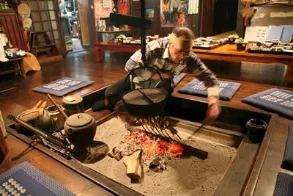
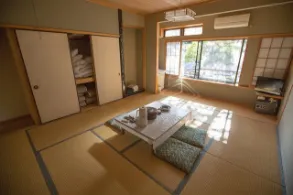
The classic Japanese inn, Ryokan come in many styles, but are united by flawless service and exquisitely-prepared food. Ryokan may be in modern or traditional wooden buildings, but rooms are always Japanese style, with Tatami (straw mat) floors and futons for sleeping laid out in the evening by the Ryokan staff. Minshuku are similar to Ryokan but family-run and with less formal service. Rooms are more simply-furnished and guests typically lay out their own futons.
As with Ryokan, the meal at a Minshuku is the highlight of the stay. Many Minshuku owners grow their own vegetables; fish, meat and other ingredients are sourced fresh each day.
Both Ryokan and Minshuku provide cotton Yukata gowns you wear after check-in. Wear them, too, when eating dinner or going for a short stroll outside. Ryokan rooms sometimes have private bathrooms, but Minshuku offer toilet and bathing facilities ‘along the corridor’. Baths may be smaller rooms, used privately in turn by guests; or they may be larger communal bathing suites, one for men and one for women.
At Japanese inns on the trip, tatami-mat rooms are culturally less intimate spaces than western bedrooms and Japanese guests travelling in a group are accustomed to sharing. On our small-group guided tours, we follow this Japanese custom and will ask solo travellers to share a tatami-mat room with another group member of the same gender.
Ryokan and Minshuku Etiquette
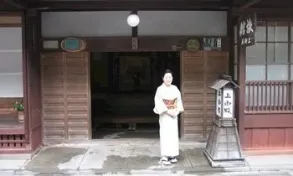
Arrival
When you arrive, step inside the Genkan street-level entrance area. Call out ‘gomenkudasai’ to attract attention if necessary. Remove your shoes and step up onto the raised interior floor, without touching the Genkan floor with your stocking feet. Leave your shoes in the Genkan area.
Slippers are normally available near the entrance for your use. Your hosts may ask you to write in the register or hand over your passport so they can take your details. The Ryokan owner or staff member will show you to your room and explain the time and place for meals, the location and hours of the bathing area.
As you enter your room, remove your slippers before stepping onto the Tatami matting. You should only tread on the Tatami mats in socks or bare feet. The slippers can be worn anywhere else inside the inn, except the toilets. Many inns provide special outdoor Geta clogs if you want to go outside without putting your shoes back on.
In your room you will usually find a small table with a tea set, a hot water flask and a welcome sweet. Look in the closets for your Yukata cotton robe and an Obi sash to tie it. You will usually find a small, white towel for washing and bathing. You may also find a small toothbrush and toothpaste kit.
Put on your yukata over your underwear. You can wear the yukata anywhere inside the Ryokan, including the dining area; it is also acceptable to wear the yukata outside. Wrap the left side of the Yukata over the right side. Most guests like to bathe before dinner – some like to bathe both before and after! If your room has a private bathroom, you will find shampoo and liquid soap, but do not take these to the communal baths as they will be supplied there too. Do take your small white towel to the communal bathing area.
Bathing
Ryokan have communal bathing areas, segregated by gender, with large baths and showers. Ryokan near thermal water sources have natural hot-spring baths called Onsen. There may be both indoor and outdoor baths. Even if your room has its own private bath, it is well worth trying the larger communal facilities.
Smaller Ryokan and Minshuku may offer bathing only in the evening and they will tell you the times when you arrive. Japanese guests traditionally bathe in the evening and communal baths or showers may not be available in the morning.
The bathing area will normally have Noren curtains over the entrance – red for women, blue for men. Inside you will find the changing area, with shelves and baskets for your clothing. Remove your clothes, place them in the basket and keep with you just your small white hand towel. If you have a larger bath towel too, leave it in the basket as it will get wet if taken into the bathing area. It is acceptable for men to take a razor for shaving into the washing area.
Proceed to the bathing area. Smaller inns may have a bath large enough for only a few people, or a small domestic tub used privately in turn by guests. Larger Onsen inns may have baths which can accommodate 25, 50 or more people. Take a small stool and bucket and find a free space in front of the taps and showers. Sit on the stool and use your white hand towel to wash yourself, using the supplied shampoo and liquid soap.
Once you have scrubbed yourself thoroughly, rinse all the soap from your body before entering the bath tub – you will be very unpopular with your fellow bathers if you make the water soapy! Leave your hand towel on the side of the bath or nearby, but do not immerse in the bath water. If you are bathing privately, do not drain the bath following your soak.
Many Japanese wash, soak, then wash again. It is fine to take your time soaking, relaxing and chatting to your neighbours.
Hotels
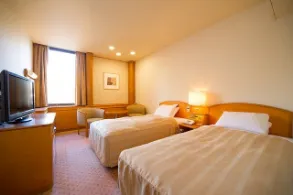
Japanese hotels have western-style rooms with beds; some may have Japanese-style Tatami rooms also. They have the same amenities as those in other countries, although room sizes are generally smaller. Hotels in Japan generally offer twin rooms; double rooms are less common and sometimes smaller than twin rooms.
4 x Breakfasts & 4 x Dinners included.
Japanese cuisine is the highlight of many people’s visit to Japan and this is especially the case on the Nakasendo Trail. Your trip includes all breakfasts and 4 evening meals whilst on the trail.
Most meals will be Japanese cuisine, though breakfast in western-style hotels usually includes more familiar choices.
Dinner and breakfast in ryokan and minshuku are set meals, usually with a whole succession of different dishes which will delight you. Alcoholic and soft drinks are not included with meals. Tipping is not customary at hotels and restaurants in Japan.
Water is drinkable from the taps on this trip. Please fill your personal bottles for your day in the morning. We do not encourage the purchasing of single use plastic bottles.
If you are vegetarian please be advised that, outside of the cities, it is hard to guarantee that dishes are 100% vegetarian. Most Japanese dishes involve miso, dashi or soy sauce, all of which contain fish and vegetarianism is not a concept that is widely understood.
Adventurous Ewe has partnered with Water-to-Go, a filtration system that eliminates over 99.99% of all microbiological contaminants from any non-salt water source – for more info please click here. Adventurous Ewe trekkers will receive a free Water-to-Go bottle when departing on our Nakasendo Trail Self-Guided Trek, and better still, 15% of the purchase value for replacement filters will be donated to our environmental charity partner, Cool Earth. Please note that if the water freezes it will clog up the filter – in this event, defrost before use by sitting the filter in lukewarm water for 10-15 minutes. Please help us reduce the volume of single use plastic in this pristine environment.
Deposit: £275 per person on booking and non-refundable
Balance: £2200 per person is due no later than 60 days prior to the trip start date.
Total cost: £2475 per person
Monthly payment plan
A monthly payment plan can be arranged for this trip. Please contact us for more information or to set up your plan. Simply email info@adventurousewe.co.uk or call 01492 588 069.
Book & Travel with Confidence
As well as carefully crafting amazing and meaningful adventures across the planet, we’ve made booking them as flexible, safe and as simple as possible.
For the latest info regarding booking and travelling with Adventurous Ewe, please refer to our Booking Conditions.
Fundraising
You’re welcome to fundraise for a charity of your choice if you wish to do so. All sponsorship monies are to be sent directly to your chosen charity.
| Departure & Return | Duration | Availability | Deposit | Total Cost* | (*Total cost includes the deposit) |
| Aug 10, 2024 Aug 16, 2024 |
7 Days | Available | £275.00 | £2475.00 | Book Now |
| Sep 07, 2024 Sep 13, 2024 |
7 Days | Available | £275.00 | £2475.00 | Book Now |
| Oct 12, 2024 Oct 18, 2024 |
7 Days | Available | £275.00 | £2475.00 | Book Now |
| Nov 02, 2024 Nov 08, 2024 |
7 Days | Available | £275.00 | £2475.00 | Book Now |
| Apr 12, 2025 Apr 18, 2025 |
7 Days | Available | £275.00 | £2475.00 | Book Now |
| May 10, 2025 May 16, 2025 |
7 Days | Available | £275.00 | £2475.00 | Book Now |
| Jun 14, 2025 Jun 20, 2025 |
7 Days | Available | £275.00 | £2475.00 | Book Now |
| Jul 05, 2025 Jul 11, 2025 |
7 Days | Available | £275.00 | £2475.00 | Book Now |
| Aug 09, 2025 Aug 15, 2025 |
7 Days | Available | £275.00 | £2475.00 | Book Now |
| Sep 13, 2025 Sep 19, 2025 |
7 Days | Available | £275.00 | £2475.00 | Book Now |
| Oct 04, 2025 Oct 10, 2025 |
7 Days | Available | £275.00 | £2475.00 | Book Now |
| Nov 01, 2025 Nov 07, 2025 |
7 Days | Available | £275.00 | £2475.00 | Book Now |
What's Included?
PRE-TRIP:
- Personalised trip support in the lead up to your trek from Adventurous Ewe
- Trek training guide
- Discount on personal kit from independent outdoor retailers both in shop and online
- Trip info supplied via our free mobile travel app
- Public liability insurance
- Financial Protection for your booking
- Monthly payment plan available
- Risk assessment and emergency management planning
- Free Adventurous Ewe Water-to-Go Bottle
DURING YOUR TRIP:
- Topographical maps
- Detailed day-by-day itinerary and walking directions
- Navigation app
- Local support by telephone
- 2 nights at city-centre hotel in Tokyo
- 4 nights at Japanese inns along the Nakasendō Trail
- 4 breakfasts and 4 dinners
- Train tickets from Kyōto or Tōkyō to the trail and from the trail to Tōkyō
- Train tickets for intermediate journeys on the Nakasendō trail
- Our Preparing for your trip and Travelling in Japan guidebooks.
What's Not Included?
- Travel insurance (mandatory)
- Visa – if required – British citizens refer to Japan Entry Requirements
- Return flights to Tokyo Japan, Haneda Airport. These can be arranged for you at an additional cost through our Flight Agent who is ATOL protected
- Airport transfers however Haneda airport is very close to Tokyo city and serviced by multiple trains, taxi’s and monorail
- Drinks and meals not included in itinerary
- Daily luggage transfer, we provide details on how this can be easily arranged
- Local bus journeys which must be paid directly to the bus driver (around ¥800, £GBP5 or $US9)
- Single room supplement(s) for solo occupancy
- Personal spending money
- Kit and equipment as listed on your kit list and medication
- Services not mentioned in the itinerary
- Expenditure of personal nature
- Any associated costs with leaving the trek early.
TRIP EXTENSIONS
If you wish to extend your stay in Japan or wish to organise a local guide, we can help you with plenty of recommendations of things to do and see. For more information, please contact us at info@adventurousewe.co.uk.
SUSTAINABLE AND RESPONSIBLE TRAVEL
Adventurous Ewe is committed to delivering our trips in a responsible and ethical manner with sustainability at its core. We respect and aim to operate our adventures to benefit local people, their economy and the environment! As such we have attained the Travelife Partner level award which recognises the long-term efforts of Adventurous Ewe regarding sustainability and Corporate Social Responsibility.
This means that Adventurous Ewe complies with more than 100 criteria, related to an operator’s office management, product range, international business partners and customer information. The Travelife Partner level standard is covering the ISO 26000 Corporate Social Responsibility themes, including environment, biodiversity, human rights, and labour relation. Travelife is the leading international sustainability certification for the travel sector. More than 35 national travel associations are promoting the scheme to their members including, SMAL, APAVT, UHPA, ANVR, ABTA, PATA and more.
Some of the ethical features embedded in our Nakasendō Trail Japan Self-Guided Trek are:
- We have a local branch in the beautifully-preserved Nakasendo post town of Tsumago after renovating a traditional Kominka home. This branch enables you the unique opportunity of getting to know the local communities we work with. Our local team can show you around the village and introduce you to local shopkeepers and villagers, who can offer a fascinating insight into what this rural lifestyle means to them.
- Building meaningul connections with people. We want to foster genuine interaction between local populations and visitors – staying in family-run inns, meeting craftspeople and artists, and experiencing the unique, everyday qualities of each particular destination.
- We aim to ensure the long-term sustainability of natural resources, culture and society, treating them with respect and fairness. Wherever possible we choose smaller lodgings owned and run by local people.
- Food and carbon footprint. Our accommodation suppliers value locally-produced food, which has a lower carbon footprint and further encourages economic activity in the community.
- Travelling by world-famous bullet train to Nagoya.
- Minimising plastic waste wherever possible.
- Offering real life experiences which promote cross-cultural understanding.
- Operating with a ‘leave no trace’ ethos – take only memories, leave only footprints
- To help eliminate our single use plastic footprint in Japan, we provide a free Water-to-Go bottle to all trekkers on departure
- Adventurous Ewe will make a financial contribution to the environmental charity, Cool Earth, as part of our business partnership.
Together, we can all make a difference in helping preserve this precious and wonderful planet.
 Difficulty
Difficulty

